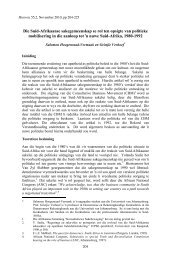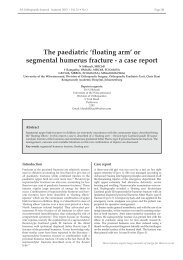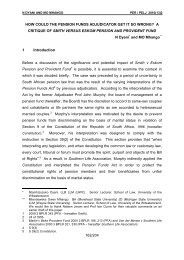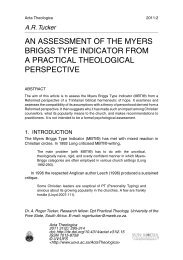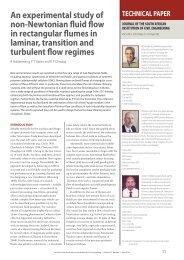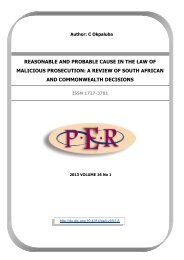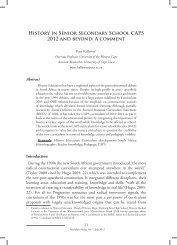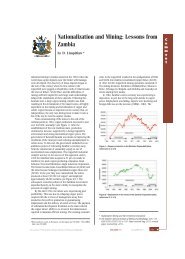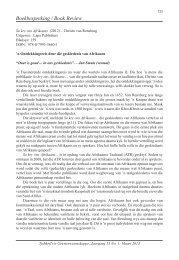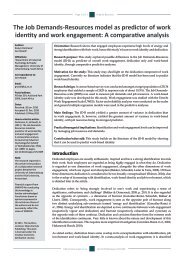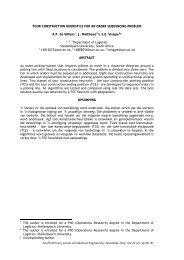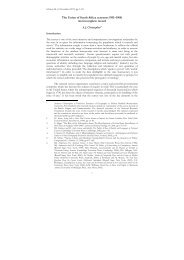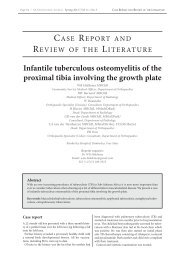A detailed analysis of evolution of water rights in South Africa: An ...
A detailed analysis of evolution of water rights in South Africa: An ...
A detailed analysis of evolution of water rights in South Africa: An ...
You also want an ePaper? Increase the reach of your titles
YUMPU automatically turns print PDFs into web optimized ePapers that Google loves.
The colonial <strong>water</strong> <strong>rights</strong> policy excluded the <strong>Africa</strong>ns who<br />
could not compete <strong>in</strong> the land markets freely and also did not<br />
have the resources to do so where such access was possible.<br />
Around 1900, various legislations were aimed at dispossess<strong>in</strong>g<br />
Black <strong>Africa</strong>ns. For example, legislation such as the Native<br />
Land Act (27 <strong>of</strong> 1913) (divid<strong>in</strong>g the land between Black and<br />
White people), the Development Trust and Land Act (18 <strong>of</strong><br />
1936) (prevent<strong>in</strong>g <strong>Africa</strong>ns from own<strong>in</strong>g land <strong>in</strong> their own<br />
right), and the Group Areas Act (41 <strong>of</strong> 1950) clearly controlled<br />
the majority Black people’s access to land and hence to<br />
<strong>water</strong> (Ste<strong>in</strong>, 2005). At the same time, the Land Bank <strong>of</strong> <strong>South</strong><br />
<strong>Africa</strong> was mobilised to help White farmers as part <strong>of</strong> a policy<br />
to reduce White unemployment.<br />
In addition to the orig<strong>in</strong>al prov<strong>in</strong>ces compris<strong>in</strong>g the Union<br />
<strong>of</strong> <strong>South</strong> <strong>Africa</strong> (Transvaal, Orange Free State, Natal, and<br />
Cape), there were 4 <strong>in</strong>dependent and autonomous states and<br />
6 self-govern<strong>in</strong>g territories – formation <strong>of</strong> these states was<br />
a policy <strong>of</strong> apartheid to create separate jurisdiction for the<br />
orig<strong>in</strong>al <strong>in</strong>habitants. These territories and states had legislative<br />
power to repeal, amend or replace the 1956 Act. However,<br />
none <strong>of</strong> them, except Bophuthatswana, made any changes to<br />
the Act. Bophuthatswana adopted the dom<strong>in</strong>us flum<strong>in</strong>is pr<strong>in</strong>ciple<br />
<strong>in</strong>to law <strong>in</strong> 1988. In a nutshell, the right to the use <strong>of</strong> <strong>water</strong><br />
cont<strong>in</strong>ued to be based on the pr<strong>in</strong>ciple <strong>of</strong> dom<strong>in</strong>us flum<strong>in</strong>us as<br />
the majority <strong>of</strong> land was state owned <strong>in</strong> these national states<br />
and self-govern<strong>in</strong>g territories; the land ownership <strong>in</strong> these<br />
states was governed by <strong>Africa</strong>n customary law (Thompson et<br />
al, 2001).<br />
Water <strong>rights</strong> under democratic rule<br />
(1990s onwards)<br />
The most important challenge for post-apartheid democratic<br />
<strong>South</strong> <strong>Africa</strong> with its neo-liberal <strong>in</strong>cl<strong>in</strong>ation was to<br />
f<strong>in</strong>d the balance between the traditional view that <strong>water</strong><br />
is a public good and the modern view that <strong>water</strong> also has<br />
a commercial value. The current legislative framework<br />
made a marked shift from previous <strong>water</strong> laws; it sought to<br />
address the social <strong>in</strong>equities and environmental concerns<br />
on the one hand and efficiency-related issues on the other.<br />
The Constitution <strong>of</strong> <strong>South</strong> <strong>Africa</strong>, which was f<strong>in</strong>ally adopted<br />
<strong>in</strong> 1996, conta<strong>in</strong>s a Bill <strong>of</strong> Rights (Chapter 2) that ensures<br />
<strong>rights</strong> <strong>of</strong> <strong>in</strong>dividuals to environment and <strong>water</strong>. The concerns<br />
relat<strong>in</strong>g to social <strong>in</strong>equities and environment are <strong>of</strong><br />
paramount importance <strong>in</strong> the <strong>South</strong> <strong>Africa</strong>n Constitution.<br />
Section 24 provides that ‘Everyone has the right (a) to an<br />
environment that is not harmful to their health or wellbe<strong>in</strong>g;<br />
and (b) to have the environment protected, for the<br />
benefit <strong>of</strong> present and future generations, through reasonable<br />
legislative and other measures that (i) prevent pollution<br />
and ecological degradation; (ii) promote conservation;<br />
(iii) secure ecologically susta<strong>in</strong>able development and use <strong>of</strong><br />
natural resources while promot<strong>in</strong>g justifiable economic and<br />
social development.’ Section 27 provides for the right to<br />
<strong>water</strong> as follows: ‘(1) Everyone has the right to have access<br />
to (a) healthcare services… (b) sufficient food and <strong>water</strong>;<br />
…(2) The state must take reasonable legislative and other<br />
measures , with<strong>in</strong> its available resources, to achieve the<br />
progressive realisation <strong>of</strong> each <strong>of</strong> these <strong>rights</strong> (RSA, 1996<br />
pp. 11-13).’ These 2 fundamental <strong>rights</strong> form the backbone<br />
<strong>of</strong> <strong>South</strong> <strong>Africa</strong>n <strong>water</strong> law. Also, <strong>water</strong> is classified as a<br />
resource <strong>of</strong> exclusive national competence as it does not<br />
appear <strong>in</strong> Schedule 4 and 5 <strong>of</strong> the Constitution, thus confirm<strong>in</strong>g<br />
its significance to the country (RSA, 1996).<br />
Although the Act <strong>of</strong> 1956 had been seen as a reversion<br />
towards a state as dom<strong>in</strong>us flum<strong>in</strong>is, as it made provisions for<br />
<strong>in</strong>creas<strong>in</strong>g government control over <strong>water</strong>, the government<br />
powers were not widely used to dilute the riparian <strong>rights</strong> <strong>in</strong><br />
essence (Kidd, 2009). The 1956 Act was heavily based on riparian<br />
<strong>rights</strong>, privileg<strong>in</strong>g White riparian farmers and exclud<strong>in</strong>g the<br />
majority <strong>of</strong> <strong>South</strong> <strong>Africa</strong>ns from access to <strong>water</strong> <strong>rights</strong> (WLRP,<br />
1996). The Recommendations <strong>of</strong> the Water Law Review Panel<br />
formed the basis <strong>of</strong> the White Paper on a National Water Policy<br />
for <strong>South</strong> <strong>Africa</strong> (DWAF, 1997). The White Paper <strong>in</strong>dicated<br />
that <strong>in</strong> 1997 about 12-14 m. <strong>South</strong> <strong>Africa</strong>ns (out <strong>of</strong> 40 m.) were<br />
without access to safe <strong>water</strong> and over 20 m. without access<br />
to adequate sanitation (Kidd, 2009). The new development<br />
vision <strong>of</strong> the country – the Reconstruction and Development<br />
Programme – formed the basis for overhaul<strong>in</strong>g the legal system<br />
and build<strong>in</strong>g new laws, <strong>in</strong>clud<strong>in</strong>g <strong>water</strong> laws, for its people.<br />
The new <strong>water</strong> law was built on some 28 basic pr<strong>in</strong>ciples<br />
as discussed <strong>in</strong> the White Paper (DWAF, 1997). The first 4 key<br />
pr<strong>in</strong>ciples laid the legal foundation <strong>of</strong> the law and these stated<br />
that: the <strong>water</strong> law is to be subjected to and also be consistent<br />
with the Constitution (Pr<strong>in</strong>ciple 1); all <strong>water</strong>, irrespective <strong>of</strong> its<br />
occurrence <strong>in</strong> the <strong>water</strong> cycle, is a common resource and its use<br />
is subject to national control (Pr<strong>in</strong>ciple 2); there is no ownership<br />
<strong>of</strong> <strong>water</strong> but only a right (environment and basic human<br />
needs) or an authorisation for its use; and any authorisation is<br />
not granted <strong>in</strong> perpetuity (Pr<strong>in</strong>ciple 3).; the riparian pr<strong>in</strong>ciple<br />
is abolished (Pr<strong>in</strong>ciple 4). The 2 nd set <strong>of</strong> pr<strong>in</strong>ciples related to<br />
recognition <strong>of</strong> <strong>water</strong> cycle as resource (Pr<strong>in</strong>ciples 5 and 6). The<br />
3 rd set <strong>of</strong> pr<strong>in</strong>ciples which guided the <strong>water</strong> resource management<br />
priorities clearly laid the ground rules for <strong>water</strong> managers<br />
<strong>of</strong> the country, suggest<strong>in</strong>g that: the objective <strong>of</strong> manag<strong>in</strong>g<br />
<strong>water</strong> (quantity, quality, and reliability) is to achieve optimum,<br />
long term, environmentally susta<strong>in</strong>able social and economic<br />
benefit for the society from their use (Pr<strong>in</strong>ciple 7); the access<br />
to <strong>water</strong> for all and <strong>water</strong> required for meet<strong>in</strong>g ecological<br />
functions are reserved (Pr<strong>in</strong>ciples 8 and 9). The use <strong>of</strong> <strong>water</strong><br />
for meet<strong>in</strong>g basic human needs and the needs <strong>of</strong> the environment<br />
are reserved and prioritised. The <strong>in</strong>ternational obligations<br />
through treaties and <strong>rights</strong> <strong>of</strong> neighbour<strong>in</strong>g countries<br />
are to be recognised (Pr<strong>in</strong>ciple 11). The 4 th set <strong>of</strong> pr<strong>in</strong>ciples<br />
(Pr<strong>in</strong>ciples 12-21) related to <strong>water</strong> management approaches.<br />
These pr<strong>in</strong>ciples allude that the National Government is the<br />
custodian <strong>of</strong> the <strong>water</strong> resources <strong>of</strong> the nation (Pr<strong>in</strong>ciple 12);<br />
the National Government would meet this mandate by ensur<strong>in</strong>g<br />
that the development, apportionment and management <strong>of</strong> <strong>water</strong><br />
resources is carried out us<strong>in</strong>g the criteria <strong>of</strong> public <strong>in</strong>terest,<br />
susta<strong>in</strong>ability, equity, and efficiency while recognis<strong>in</strong>g the<br />
basic domestic needs, plus the requirements for meet<strong>in</strong>g environmental<br />
and <strong>in</strong>ternational obligations (Pr<strong>in</strong>ciple 13), and so<br />
on. Pr<strong>in</strong>ciples 22 to 24 are to guide the development and function<strong>in</strong>g<br />
<strong>of</strong> <strong>water</strong> <strong>in</strong>stitutions, while Pr<strong>in</strong>ciples 25 to 28 relate to<br />
provision<strong>in</strong>g <strong>of</strong> <strong>water</strong> services to people.<br />
As mentioned earlier, the development <strong>of</strong> <strong>water</strong> <strong>rights</strong><br />
<strong>in</strong> <strong>South</strong> <strong>Africa</strong> is largely h<strong>in</strong>ged upon Roman-Dutch law <strong>in</strong><br />
which rivers were seen as resources which belonged to the<br />
nation as a whole and were available for common use by all<br />
citizens, but which were controlled by the state <strong>in</strong> the public<br />
<strong>in</strong>terest – this is sometimes known as the ‘public trust doctr<strong>in</strong>e’.<br />
The concept <strong>of</strong> public trust goes back to Roman times.<br />
The Roman Emperor Just<strong>in</strong>ian codified the law <strong>in</strong> 528 AD,<br />
which has been known as the Institutes <strong>of</strong> Just<strong>in</strong>ian (Lee, 1956<br />
pp. 33-45). The Institutes <strong>of</strong> Just<strong>in</strong>ian stated that by the law<br />
<strong>of</strong> nature some th<strong>in</strong>gs are accepted as common to mank<strong>in</strong>d<br />
such as air, seashore, etc. These are def<strong>in</strong>ed as ‘commons’ <strong>in</strong><br />
702<br />
Available on website http://www.wrc.org.za<br />
ISSN 0378-4738 (Pr<strong>in</strong>t) = Water SA Vol. 35 No. 5 October 2009<br />
ISSN 1816-7950 (On-l<strong>in</strong>e) = Water SA Vol. 35 No. 5 October 2009



